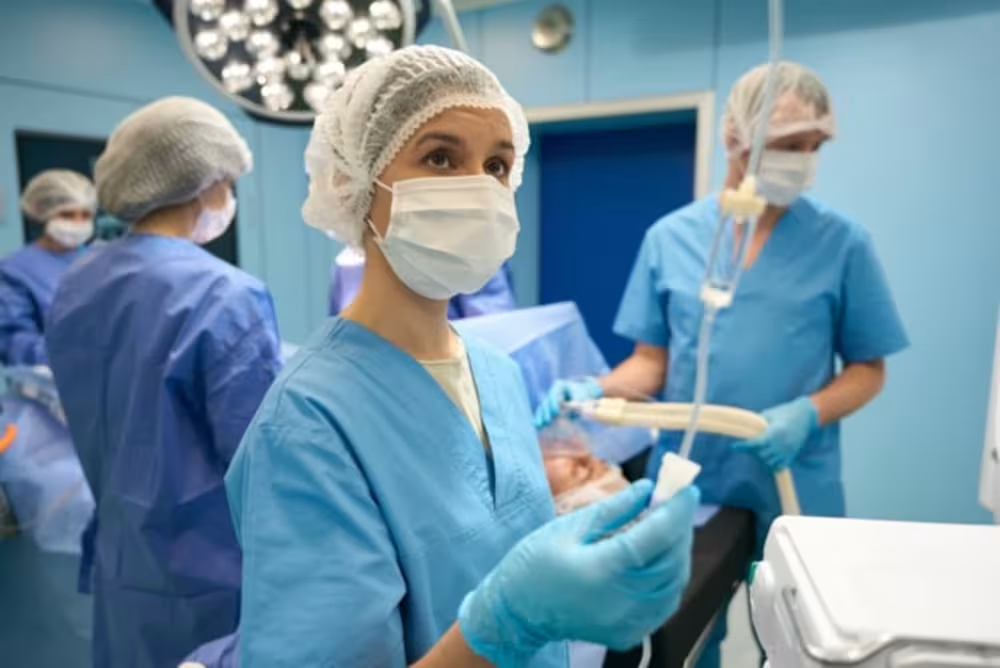How to Become a CRNA: Your Step-by-Step Guide to a Rewarding Nurse Anesthetist Career
Each blog post is dated and contains accurate information as of that date. Certain information may have changed since the blog post publication date. If you would like to confirm the current accuracy of blog information, please visit our ABSN program overview page or contact us at (866) 892-6747.
Classes held at our Syracuse learning site have been temporarily relocated to our main campus in Utica, New York. Speak with an admission representative to learn more.
A certified registered nurse anesthetist (CRNA) administers anesthetics to patients. The process of becoming a CRNA starts with earning a B.S. in Nursing and an RN license, followed by gaining clinical experience and earning one or more graduate degrees. Then, you can obtain board certification and advanced licensure.

Each year in the U.S., about 40 million doses of anesthetics are administered to patients undergoing procedures, ranging from emergency appendectomies to reconstructive plastic surgeries and more. Many of these anesthetics are administered by certified registered nurse anesthetists (CRNAs). If you’re considering pursuing a career in nursing, you may want to look at how to become a CRNA.
Even if you don’t have a nursing background and are currently working in another field, Utica University makes it possible to switch to nursing quickly. Utica’s Accelerated Bachelor of Science in Nursing (ABSN) program offers a faster pathway, conferring a B.S. in Nursing in as few as 16 months upon completion of the degree requirement courses.
Before choosing your career path, consider the answers to common questions, such as “What is a nurse anesthetist?” and “What are the nurse anesthetist schooling requirements?” Then, discover the seven steps to a rewarding career as a CRNA.
What Is a Nurse Anesthetist?
There are several different levels of nursing, including licensed practical nurses (LPNs), registered nurses (RNs), and advanced practice registered nurses (APRNs). At the highest level of nursing, APRNs hold the broadest scope of practice authority. There are four main types of APRNs: nurse practitioners (NPs), clinical nurse specialists (CNSs), certified nurse midwives (CNMs), and certified registered nurse anesthetists (CRNAs).
Specializing in administering anesthetics and other pain control medicines, nurse anesthetists are responsible for the comfort and safety of patients undergoing procedures, such as C-sections and appendectomies. First, they conduct an extensive pre-operative review of the patient’s health and medical history to determine if it’s reasonably safe for them to undergo anesthesia. Then, they obtain informed consent from the patient. Finally, CRNAs administer anesthesia and monitor patients’ conditions during and after the procedure.
What’s the Difference Between CRNAs and Anesthesiologists?
A CRNA is a healthcare professional with extensive post-baccalaureate nurse anesthetist schooling and training. CRNAs have obtained board certification and advanced licensure as APRNs.
Like CRNAs, anesthesiologists specialize in administering anesthetics and caring for patients before, during, and after surgical procedures. The main differences are in their credentials and career pathways. Where CRNAs are nurses, anesthesiologists are doctors. Like CRNAs, they undergo extensive post-baccalaureate education and training, but they attend medical school instead of a graduate-level nursing program.
How Long Does It Take to Become a CRNA?
There are many steps in the journey to becoming a CRNA, and each has a variable time for completion based on individual factors. It’s possible to become a CRNA in as few as eight to 10 years, or it can take up to 16 years. For example, a nurse starting out in a different specialty area, such as pediatric nursing, might take longer to navigate toward the nursing anesthesia specialty and the advanced education it requires.
There are also timeline differences among academic programs. If you choose a traditional B.S. in Nursing program, for example, you can expect to spend four years working toward taking the NCLEX-RN exam. On the other hand, Utica’s ABSN program can accelerate your career trajectory by allowing you to graduate in as few as 16 months. Plus, with no waitlist, you can get started sooner.

Steps to Become a Certified Registered Nurse Anesthetist
If you’re interested in how to become a CRNA, you’ll need to start by applying to nursing school.
1. Apply to Nursing School
Every nursing school establishes its own requirements and admission procedures. At Utica, our ABSN program has specialized admission representatives to assist you through each step of the process. Your admission rep will determine your eligibility for the program and help you develop a plan for taking the degree requirement courses and meeting other requirements.
2. Earn a B.S. in Nursing
The B.S. in Nursing provides a broad foundation in nursing concepts and skills. Utica offers a robust curriculum comprising online coursework, 225 hours of in-person skills and simulation labs, and 588 hours of clinical rotations. The blended curriculum builds nursing knowledge while simultaneously helping you practice and refine your new nursing skills and gain practical experience caring for patients.
You can expect to explore nursing topics such as:
- Behavioral health nursing
- Foundations of nursing care
- Health assessments
- Medical-surgical nursing care
- Obstetrics and pediatrics
- Pathophysiology
- Pharmacology
Because the ABSN program compresses the nursing curriculum into just 16 months, you can expect to maintain a busy schedule. Plan on studying every day to stay on top of the material.
3. Obtain an RN License
The first licensure exam you’ll need to take is the NCLEX-RN. Most students take this exam within a couple of months of graduation. It’s best to prepare for it well in advance by answering a few practice questions each day throughout nursing school and taking a couple of full-length practice exams. Once you pass the exam, you can obtain your registered nurse license from your state’s Board of Nursing (BON).
4. Work in a Relevant Nursing Specialty
Armed with an RN license, you can pursue work in a nursing specialty relevant to your intended career as a nurse anesthetist. It’s common for future CRNAs to choose critical care nursing, although you might also work in the intensive care unit (ICU), emergency room (ER), or surgical suite. Expect to work for about one to three years to gain clinical experience before moving on to graduate-level education.

Discover 10 nursing specialties that are in demand today, including critical care nursing
5. Obtain a Master’s Degree
You may or may not need a Master of Science in Nursing (MSN). To determine this, research doctoral programs for future certified registered nurse anesthetists. Some programs require applicants to have an MSN, while others do not. If you need to obtain an MSN or simply decide that additional nurse anesthetist schooling would be a good option for you, then plan on spending two to four years in an MSN program.
6. Earn a Doctorate
The last degree you’ll need to earn is a doctorate, which is now the minimum requirement for entry into the nursing anesthesia specialty. You can choose between a Doctor of Nursing Practice (DNP) with a CRNA focus and a Doctor of Nursing Anesthesia Practice (DNAP). One is not necessarily better than the other, and both paths take about the same amount of time.
7. Obtain Board Certification and APRN Licensure
After obtaining a doctorate, only a couple of hurdles remain in the process of how to become a CRNA. You’ll need to pass the board certification exam administered by the National Board of Certification and Recertification for Nurse Anesthetists (NBCRNA). Then, you can apply for APRN licensure.

Figure out how to pay for nursing school using scholarships, grants, and other financial aid options
Take the First Step by Applying to Utica University’s ABSN Program
At Utica University, we provide extensive student support and flexible learning options to facilitate your transition into nursing. Our ABSN program is available to students with a completed non-nursing bachelor’s degree, and our Advanced Standing B.S. in Nursing transfer pathway is designed for those with at least 65 college credits. At Utica, you can complete your B.S. in Nursing in as few as 16 months and be ready to continue your journey toward a nurse anesthetist career.
Contact an admission representative today for personalized assistance with the application process.

